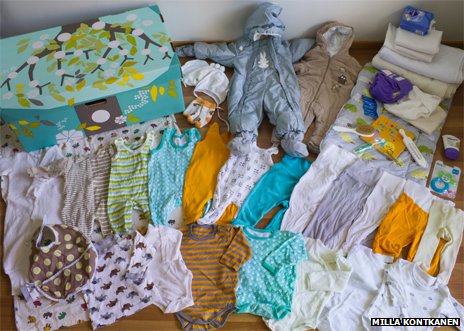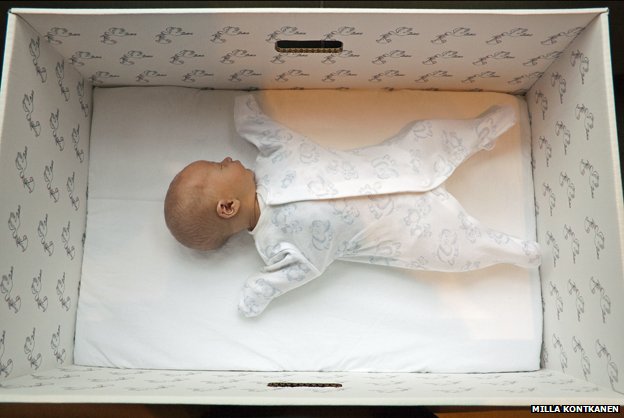Children of the Box

In the mid-1930s, infant death rates in Finland were very high, at 65 out of 1,000 live births. Social scientists attributed many of these deaths to two factors. First, expectant parents sought too little prenatal care (often because they were too poor to afford it). Second, these parents brought the baby home into a house with inadequate, well, stuff — too few diapers, not enough baby clothes, and often, nowhere for the baby to sleep. And as any parent of a newborn will tell you, the worst time to figure out what you need for a baby is when you first come home and realize, holy cow, you have a baby.
So Finland came up with an idea: a gift box, delivered before you deliver. Originally, this care package mostly consisted of a set of fabric so expectant mothers could create clothes for their newborns, along with a few other odds and ends. Over the years, the new baby box has grown into a robust cornucopia of tiny awesomeness. There’s a little mattress and concordant bedding; a snowsuit set with mittens, a hat, and booties; bodysuits, socks, and other everyday wear; some bathroom items, such as a towel and toothbrush; and even bra pads and condoms. (Here’s a full list, with pictures.)
The box truly aimed to deliver all the stuff you’ll need for your little one (and more). And to get the box, all the would-be mother needed to do was seek out a doctor for a checkup or five while pregnant. It was a win-win: expectant mothers received both the prenatal care they needed as well as free nursery gear after. The gift box program, which was originally provided only to low-income families, soon became very popular.
Today, the box has become a staple of Finnish culture. All expectant mothers who seek prenatal care are offered the baby care box, and almost all of them — 95% — take it. The remaining 5% takes a small cash amount instead, but the sum total of the items included in the box is easily worth more than the amount offered.
But the most distinctive part of the gift box offering — and the item which best defines the Finnish newborn culture — is the box itself. Because many of the poorest households couldn’t afford cribs, the boxes were specifically designed to act as cots, as seen below.

Today, according to the BBC, a majority of Finns grow up — for a few weeks or months, at least — sleeping in a box. (The lid isn’t on, don’t worry!) And the program was a resounding success. Infant mortality in Finland fell from a peak nearing 90 per 1,000 in the 1940s to the single digits by the late 1970s. Finland now has one of the lowest infant mortality rates in the world.
Bonus fact: If you’re not going to give out free baby supplies, you may want to give out free contraception. But if you do so for an international audience, please be sure to have plenty of extras available — high-quality contraception is lacking in many areas. Just as the Canadian government!
During the 2010 Winter Olympics in Vancouver, the British Columbia Centre for Disease Control distributed condoms to athletes, support staff, and volunteers at the Games. During the 17 days of the Olympics, a total of 100,000 condoms were distributed through the program — and they ran out, requiring what some media termed an “emergency” delivery of prophylactics. Assuming four staff/volunteers per athlete, that’s about three condoms per person. But most likely, they weren’t all (or even mostly) used during the two-plus weeks of athletic competition. One public health official told CNN that they “[heard] stories of athletes from countries with inferior condoms stuffing their suitcases with the coveted rubbers.”
From the Archives: Life in the Fast Lane: How Finland combats speeding.
Related: A book of nursery rhymes from around the world. Only one review, four stars.
Both images via the aforementioned BBC article.
